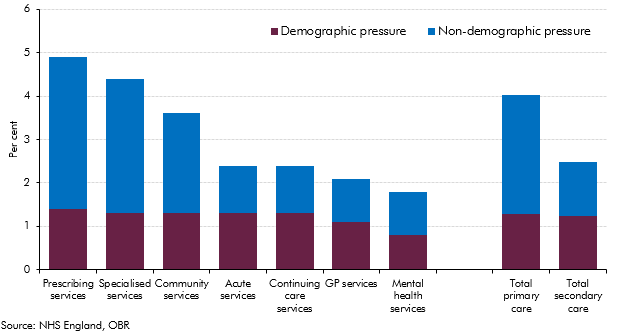Over the past four decades, health spending in the UK rose faster than GDP (on average in real terms) and it increased steadily in real per capita terms. Demographic change alone could have not explained these rising trends, with other factors expected to provide further upward pressures on health spending. This box summarised the key findings of our WP No. 9 that reviewed the latest evidence on demographic and non-demographic determinants of health spending in the UK and its implications for our long-term health spending projections.
This box is based on NHS England Five Year Forward View data from November 2016 .
In Working paper No. 9: Fiscal sustainability and public spending on health, we investigated the latest evidence on demographic and non-demographic determinants of health spending in the UK and its implications for our long-term health spending projection.
Most notably, in the UK public spending on health has increased by 3.8 per cent a year on average in real terms since 1978-79, while the economy has grown by an average of just 2.2 per cent a year. Health spending in the UK has also increased steadily in real per capita terms, but demographic change alone cannot explain these rising trends, with other factors generating further upward pressures on health spending. Key findings from our review included:
- demographic effects have explained only a small part of the increase in health spending over past decades and they are likely to remain a relatively small, although growing, driver of spending in the future;
- income effects are an important driver of changes in real health spending, though not of spending as a share of GDP; and
- other cost pressures (for example increasing relative health care costs and technological advances) have been bigger contributing factors over the past and are likely to remain important drivers of spending in the future.
Our past FSR projections have not included explicit adjustments for these other cost pressures in the health sector. By contrast, international institutions such as the IMF and OECD consider these other cost pressures to be a key source of future spending growth. For example, the OECD (2013) has assumed in its ‘cost-pressure scenario’ that other cost pressures increase spending by 1.7 per cent a year beyond what would result from demographic change and income effects. The IMF (2010, 2012) has estimated an additional cost pressure for the UK of about 1.5 per cent a year between 1980 and 2008 and 2.2 per cent a year between 1995 and 2008.
One conclusion of our working paper was that when defining ‘unchanged policy’ health, spending should increase to reflect growth in other costs in our central projection. NHS England (2016) has recently estimated non-demographic cost growth pressures for the NHS up to 2020-21 by stripping out an estimate of demographic cost pressures from activity in 2015-16. As shown in Chart A, this suggests that on average other cost pressures added 2.7 and 1.2 percentage points to growth in primary and secondary care spending in 2015-16 respectively. (Secondary care makes up the majority of total spending.a) The size of the effect varies significantly by spending category, being particularly large for prescribing and specialised services. By contrast, demographic factors are similar across most services, contributing on average around 1.3 percentage points to growth in total activity.
Chart A: Demographic and non-demographic pressures (2015-16)

